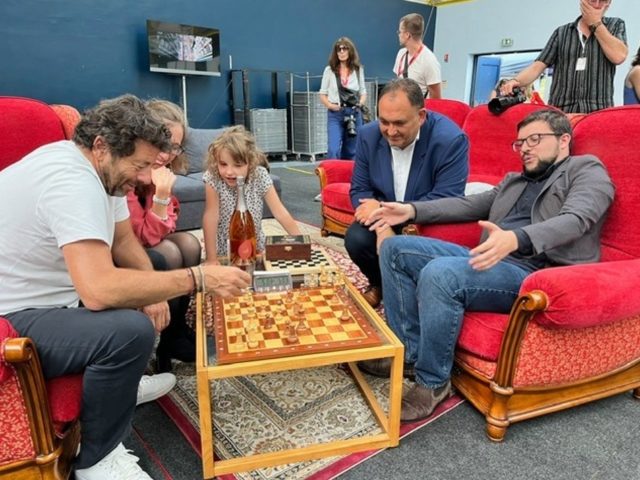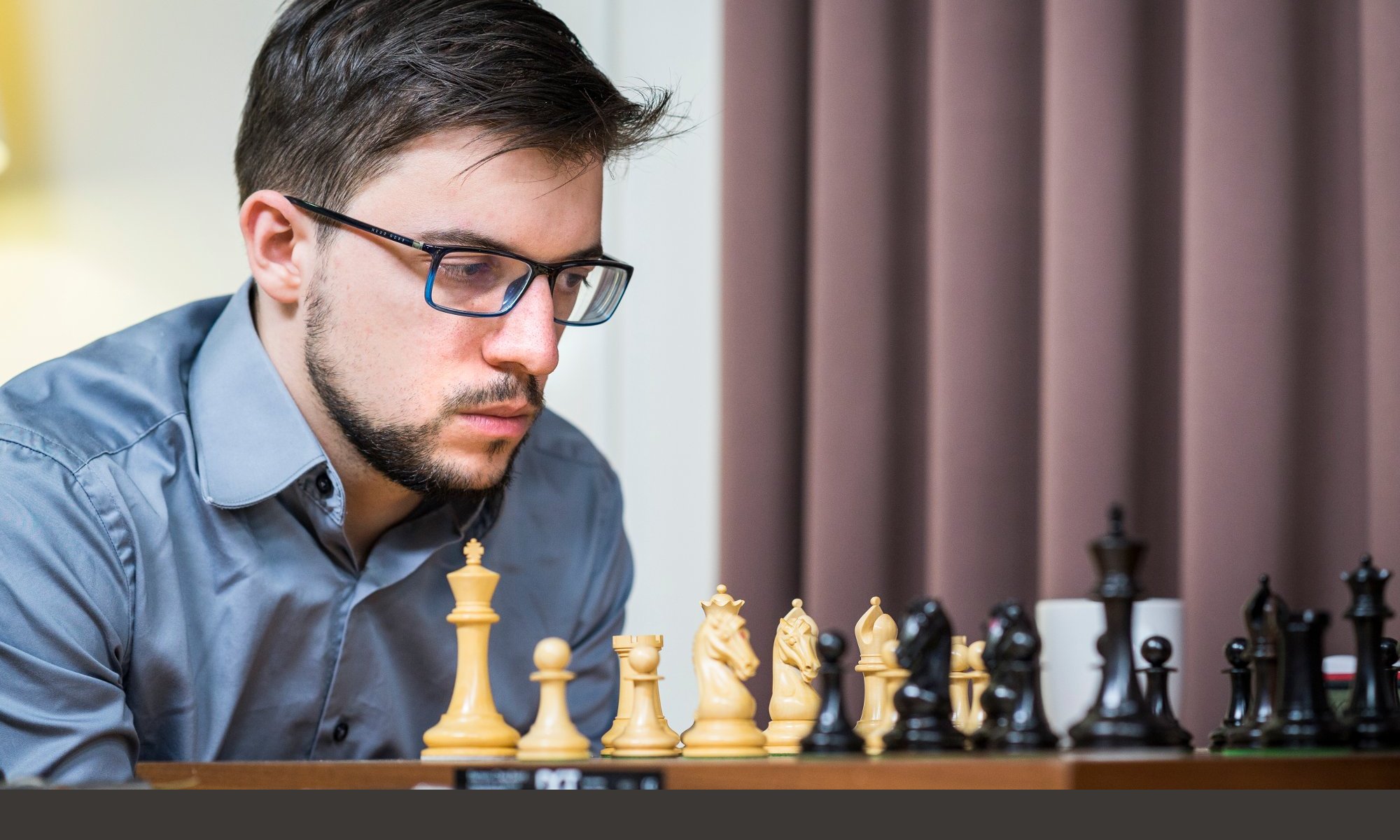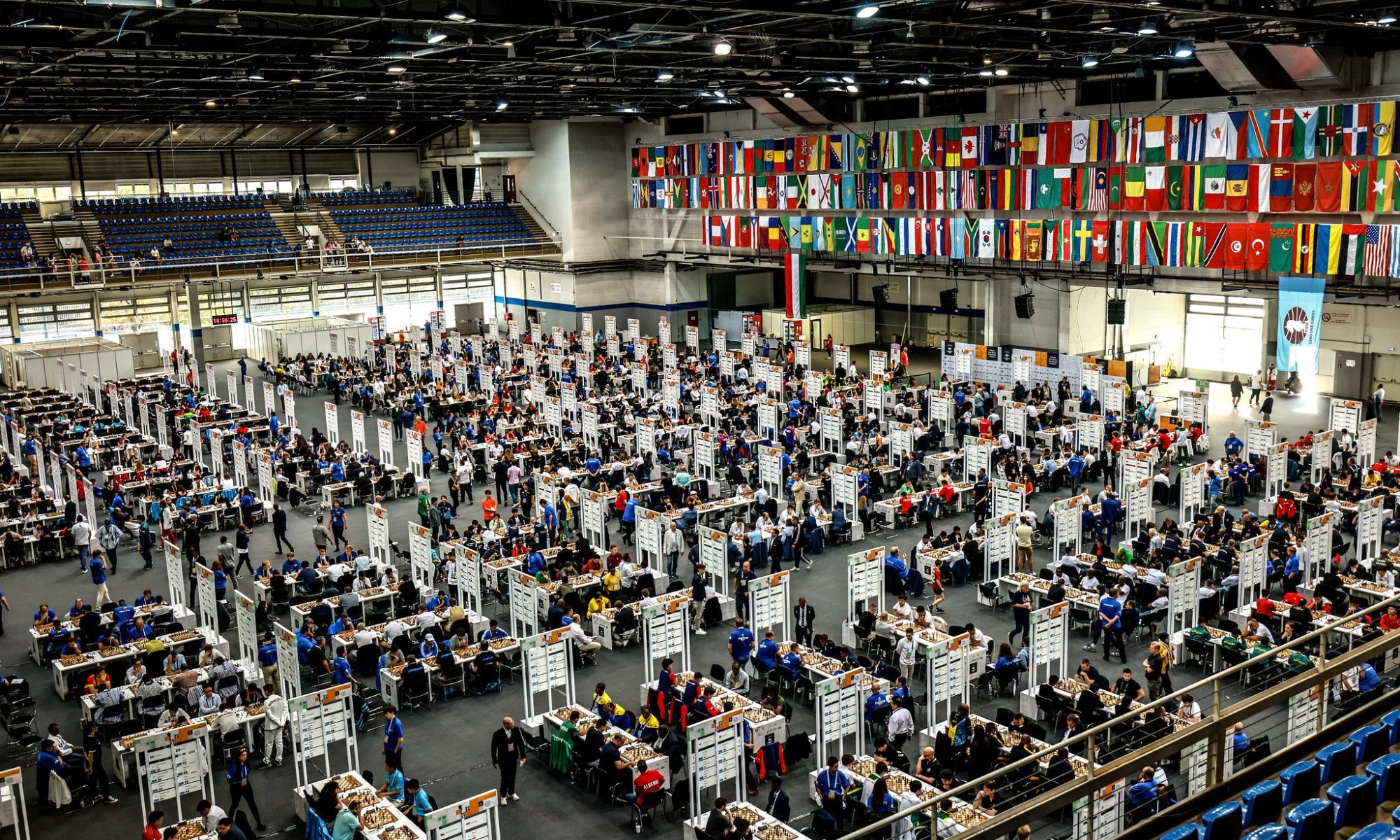Bien qu’ayant eu assez peu de repos au retour de la tournée US, j’étais content à la perspective de retrouver l’équipe de France et mes coéquipiers, d’autant que j’avais quand même manqué les Olympiades de Chennai (Inde) en 2022. Dommage qu’Alireza n’en ait pas été présent parce que ça aurait pu faire une très belle équipe face aux armadas qui étaient annoncées…
Après quelques inévitables péripéties pendant le voyage de l’équipe et lors de l’installation, nous avons rapidement pris nos marques à Budapest, avec notre QG dans un restaurant le midi, et une routine globale avant et après les matches.
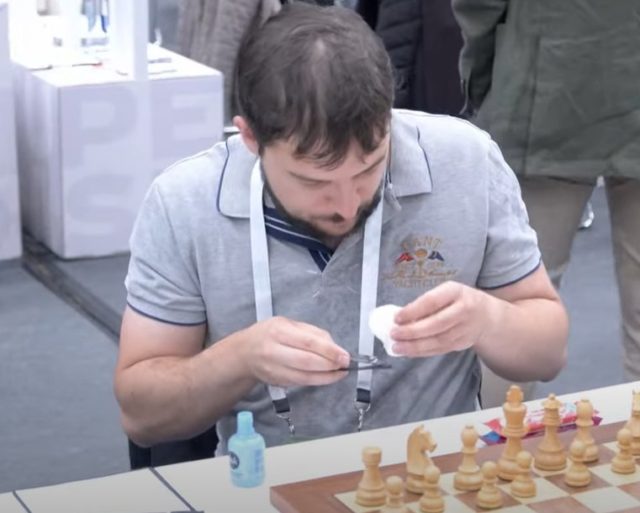
Dès ma deuxième partie (Ronde 3 contre Kadric, Montenegro), j’ai eu un problème de lunettes qui m’a bien perturbé. Je les ai retrouvées avec une branche cassée le matin (ne me demandez pas pourquoi !). Avec le capitaine de l’équipe, Sébastien Mazé, on s’est dit qu’on allait les faire réparer et nous sommes partis pour une tournée des opticiens de la capitale hongroise. Bien sûr, j’aurais préféré préparer ma partie, mais je ne peux décemment pas fonctionner dans la vie courante sans lunettes 😊. Malheureusement, tous les professionnels visités nous ont dit qu’il leur faudrait au moins 4 jours. Le problème c’était que certes, j’avais une paire de rechange, mais c’était une paire de lunettes de soleil ! (Spoiler, le règlement Fide interdit de les porter pendant les parties). Donc on a fait les malins et on a essayé de les réparer nous-même, à l’aide de super glue. Ah, c’est sûr, cette colle est super efficace, mais malheureusement pas assez pour recoller la branche, mais suffisamment pour tâcher le verre ! Ce qui fait qu’on a empiré les choses, comme souvent dans ces cas-là. Donc ma solution pendant tout le tournoi, ça a été de garder les lunettes sans branche droite pendant les parties, et de porter les lunettes de soleil le reste du temps. Même quand il pleuvait ou qu’il faisait nuit dans Budapest, on pouvait apercevoir un drôle de gugus en lunettes de soleil 😊.
Certes, je m’y suis fait et pendant les parties, ça ne m’a finalement pas tant gêné que ça. Ca ne perturbait pas mon champ de vision, les verres étaient bien placés, et la position naturelle des lunettes restait à peu près stable. J’avais juste besoin de les réajuster régulièrement, et de faire un petit peu attention qu’elles ne tombent pas.

Après cet intermède optique, revenons aux échecs ! En ce qui concerne l’équipe, alors que j’ai rapidement annulé en ce « jour des lunettes », nous avons perdu le match contre le Monténégro. Mais nous sommes bien remontés par la suite pour finir en embuscade avant la journée de repos. On est repartis ronde 7 contre la Géorgie, un match piège contre des joueurs qui ne sont pas très bien classés, mais qui sont assez expérimentés ; certes, c’est une équipe assez vieillissante, malgré l’apport d’un petit nouveau (Kacharava), mais qui ne jouait pas contre nous.
J’ai disputé une belle partie, mais nous avons tout de même été tenus en échec 2-2.
Mvl – Mchedlishvili (2574) 1-0
J’avais repéré que sur 1.c4, le joueur géorgien avait beaucoup varié pendant le tournoi, et qu’il avait l’air assez indécis. Pendant la journée de repos, j’ai donc décidé d’approfondir ça, surtout après avoir vu qu’il jouait parfois une variante de la Slave dont il ne semblait pas au fait des derniers développements. En plus, j’avais déjà essayé cette ligne avec les noirs dans les tournois en ligne de 2020-2021. Je l’avais pas mal travaillée et je savais que c’était dangereux, notamment après le sacrifice de pion dans la position suivante :
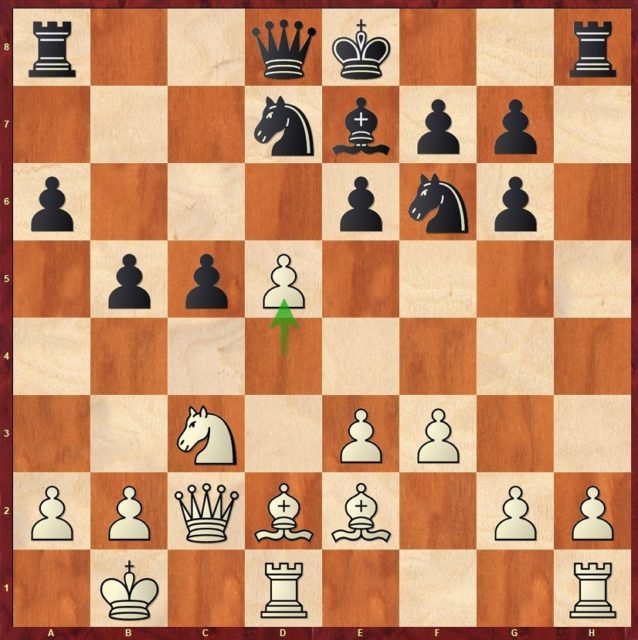
Malgré cette bonne base, je me suis un peu planté parce que je me souvenais de 15…Cxd5 en coup principal, et sur 15…exd5 j’avais en mémoire 16.Fc1 Db6!. Je savais donc que 16…Cb6?! n’était pas bon, mais je ne savais pas pourquoi ! Après 17.g4 b4, je n’ai pas du tout pensé à 18.Ca4!, un coup difficile qui constituait la vraie réfutation. En effet, après 18.Cxd5 Cfxd5 19.e4 Cc3+ 20.bxc3 Dc8, j’ai joué 21.cxb4? un peu par dépit parce que je sentais que je n’avais pas optimisé. J’avais envisagé 21.h4, qui était le coup pour prendre l’avantage en dissuadant notamment les noirs de roquer, mais je n’y ai pas cru. Dans la partie, alors qu’il avait des compensations pour les deux pions sacrifiés, il m’a laissé consolider progressivement ma position.
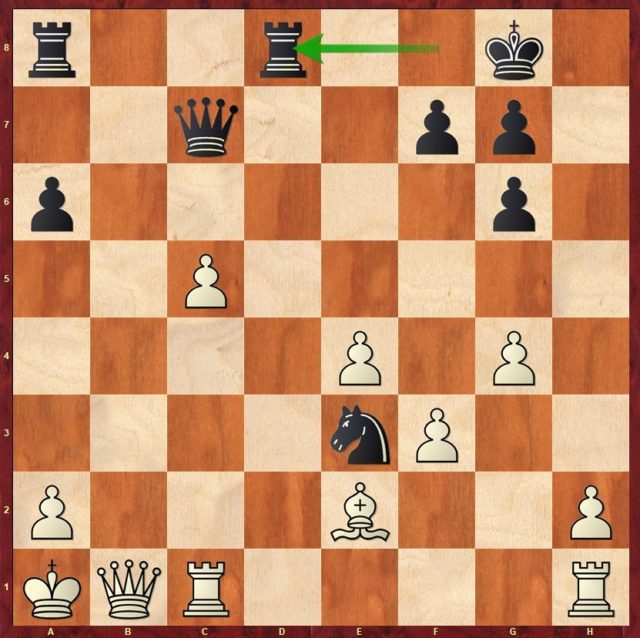
A partir de ce moment-là j’ai très bien joué. Il y avait un petit semblant d’attaque pour les noirs, mais en réalité pas suffisamment… 28.Db3! (en route vers c3, d’où la Dame contrôlera à peu près tout) 28…Df4 29.Dc3 Tac8 30.Fd1! Tc7 31.Fb3 (une manœuvre de Fou plutôt bien vue ; le Fb3 est idéalement placé en défense, mais il lorgne également vers f7, ce qui portera ses fruits plus tard) 31…Tdc8 32.Dd4! Dxf3 33.The1 et certes j’ai rendu les pions, mais mes pièces sont maintenant idéalement coordonnées pour conclure.
Malheureusement, on n’a pas gagné ce match alors qu’il était complètement maîtrisé. On a donc été punis tout de suite puisque nous avons été appariés contre les États-Unis et ses cinq joueurs à 2700+ à la ronde suivante, alors que si on l’avait emporté, on jouait la Hongrie…
Pour ma part, j’ai déjà joué les 4 membres principaux de l’équipe US au moins une vingtaine de fois chacun, si ce n’est beaucoup plus pour certains parce que Levon (Aronian) et Fabiano (Caruana), je pense que (en comptant toutes les cadences), ce serait plutôt entre 150 et 200 fois !
Caruana (2798) – Mvl 1/2
Au premier échiquier, j’avais donc les noirs contre Fabiano, et nous sommes rapidement arrivés dans la position suivante, issue de la variante 3.Fb5+ contre la Sicilienne.
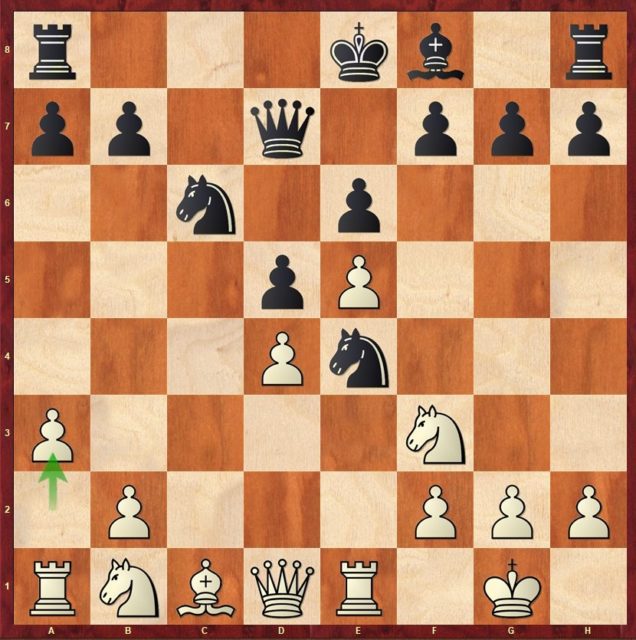
J’avais regardé ce coup 11.a3 il y a longtemps,sans doute plus de 3 ans. Mais pendant le stage avec l’équipe de France à Vichy, juste avant les Olympiades, nous avions discuté pendant quelques minutes de cette idée, mais je ne me suis pas souvenu des détails et j’ai donc improvisé 😊. De plus, dans la stratégie de match, comme on avait décidé qu’Étienne jouerait hyper solide avec les blancs contre Wesley (So), l’idée c’était évidemment que pour moi, nulle serait un très bon résultat avec les noirs ; mais que néanmoins, si je pouvais éviter de tout neutraliser et garder quelques options ouvertes, ce ne serait pas plus mal.
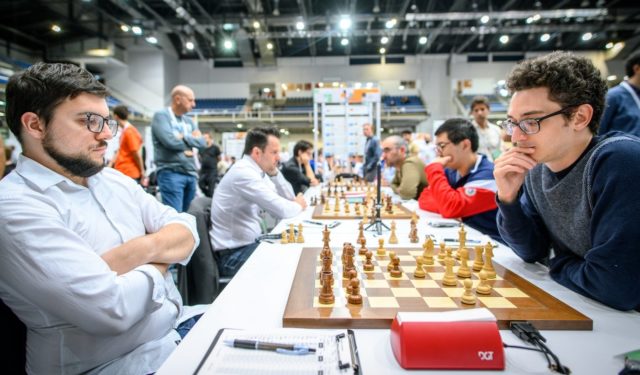
Donc j’ai joué dans cet esprit, en essayant de ne pas me retrouver un petit peu moins bien à défendre un truc sans perspective, et de me réserver quelques possibilités de contre-jeu.
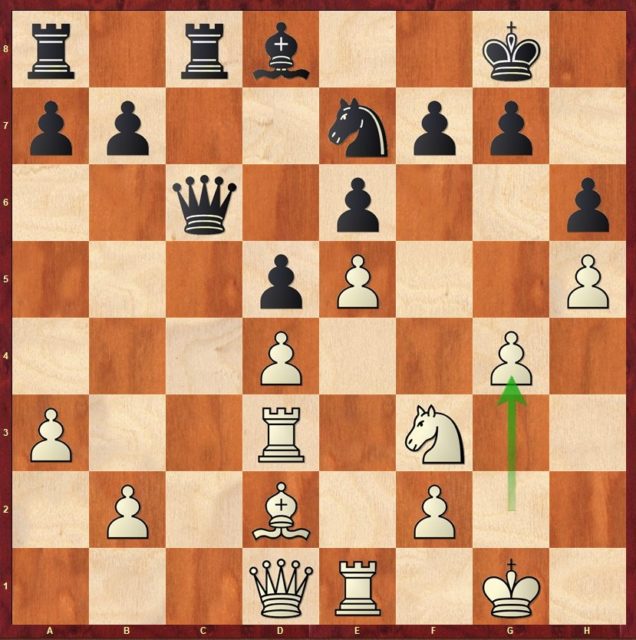
Un moment critique car ici Fabiano m’a laissé faire 19…Dc2 calculant qu’il pourrait profiter de la Tour noire encerclée en c2, mais ce n’était pas le cas ! Après 20.Dxc2 Txc2 21.Fc3 Cc6, il a joué 22.Ted1. Son idée de base, c’était 22.Tb1, mais il y a 22…Te2! (l’ordi dit que 22…Fg5 va aussi, mais ça laisse 23.Tdd1, ou même 23.Cxg5 hxg5 24.Fd2, et d’ailleurs je pensais qu’il jouerait ça) 23.Cd2 (pour jouer 25.Rf1 ; si 23.Rf1 de suite, alors 23…Te4 24.Ch2 f6, ma Tour arrive en f4, et même si c’est un peu acrobatique, elle ressortira !) 23…Fh4 et si 24.Tf3? Cxd4.
Avec la Tour en d1, j’ai joué 22…Fg5 puisque 22…Te2? ne marche plus à cause de 23.Cd2 Fh4 24.Cf3 et la prise en d4 n’est plus possible, la Cd2 étant protégé.
Après 23.Ce1 Tc1 24.Txc1 Fxc1, en dépit de son apparente symétrie, cette finale n’est pas complètement évidente parce que les noirs manquent quand même d’espace et que si les blancs arrivent à jouer f4-f5 ça peut vite devenir compliqué à l’aile-Roi. Toutefois, j’ai plutôt bien géré cette situation et j’ai même obtenu quelques petites chances vers le 40e coup quand il manquait de temps ; mais il a très bien défendu et tout s’est simplifié vers la nulle.
Finalement, on a perdu ce match car Maxime (Lagarde) a gaffé dans une position assez prometteuse contre Levon, et nos adversaires ont sécurisé le reste du match.
Contre l’Italie, partie insipide de ma part, où je me suis fait totalement neutraliser avec les blancs par Vocaturo ; mais on a fini par remporter un match qui était pourtant assez mal engagé. Ensuite, on a plutôt bien maîtrisé les choses contre l’Angleterre (je me suis imposé contre Vitiugov), et nous avons abordé la dernière ronde contre les jeunes champions en titre d’Ouzbékistan, avec en jeu au moins une 5e place.
Malheureusement, nous avons fini par perdre ce match, mais on aura eu toutes nos chances parce qu’encore une fois, c’est Maxime (Lagarde), en crise de temps, qui a perdu une position pourtant très prometteuse. On peut regretter aussi la nulle d’Étienne (Bacrot), plus ou moins sans jouer avec les blancs contre Yakubboev, parce qu’autant contre So, on s’était dit collectivement que c’était le bon choix stratégique, autant là, sur une dernière ronde, on aurait préféré qu’il joue…
De mon côté, j’avais les noirs contre Abdusattorov, et c’était une ronde du matin, où par la force des choses, les révisions sont moins poussées.
Abdussatorov (2766) – Mvl 1/2
Voici la position que nous avons obtenue après 20 coups d’une Najdorf très complexe.
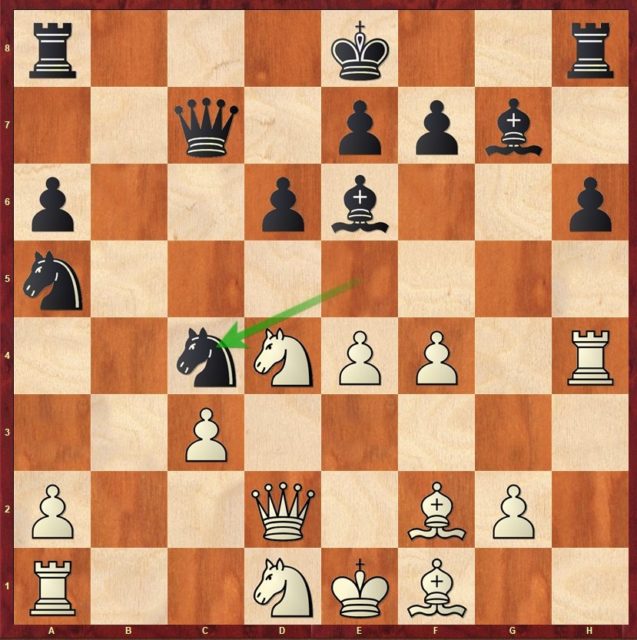
Pour la petite histoire, Vladimir Kramnik, qui était le capitaine de l’équipe d’Ouzbekistan, m’a dit juste après la partie, avec son optimisme légendaire 😊 : « mais tu étais complètement perdant s’il jouait ceci… ». Sur le coup, je croyais qu’il me disait que j’étais complètement gagnant parce qu’effectivement, plus tard dans la partie ça avait l’air plus prometteur pour moi. Mais bon, « gagnant », je ne comprenais pas non plus ! En fait, il parlait de la position du diagramme, estimant que si les blancs avaient joué 21.Cxe6 fxe6 22.Dd3 (au lieu de 21.Dd3 tout de suite, autorisant 21…Fd7!) « [ils] auraient été gagnants ».
Pour le coup, il n’a pas complètement tort dans le sens où je suis effectivement moins bien dans cette variante, mais certainement pas perdant ! C’est une position certes un peu délicate, mais qui n’a quand même pas l’air si grave et surtout, qui laissait pas mal de jeu aux deux camps.
Finalement, j’ai plutôt bien négocié la suite de la partie, et obtenu pas mal de jeu en donnant un pion. Mais ce n’était pas suffisant pour espérer gagner.
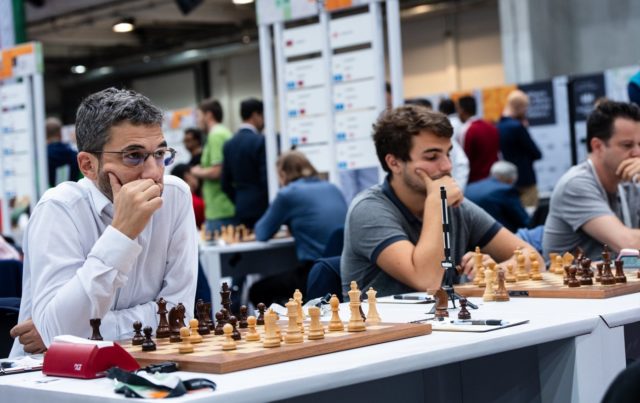
Le bilan des Olympiades est assez décevant en termes de résultat final, puisque nous terminons à la 15e place. Comme on n’avait pas une des meilleures équipes sur la grille de départ, il aurait fallu que tout le monde surperforme pour espérer un podium. Or, il est clair que personne dans l’équipe de France n’était dans une forme exceptionnelle. Il y a certes eu de bonnes choses. Laurent (Fressinet) sur la fin, Marc’Andria (Maurizzi) sur une grosse partie de tournoi (hormis sa défaite contre l’Angleterre qui était un peu dommageable) ; de son côté, Maxime (Lagarde) a mis un peu le feu, même si ça s’est retourné contre lui dans les deux matches qu’on perd à la fin. Mais dans d’autres circonstances ça aurait pu être un très bon tournoi, et en tout cas, il a le bon état d’esprit.
A titre personnel, 7/10 c’est bien, mais pas non plus prodigieux. En fait, c’est surtout un résultat qui pâtit de la comparaison avec d’autres titulaires du 1er échiquier, comme Gukesh ou Abdusattorov, qui ont réalisé des perfs stratosphériques à Budapest !
D’ailleurs, j’en profite pour saluer comme il se doit la double médaille d’or des Indiens, qui ne souffre vraiment aucune contestation…
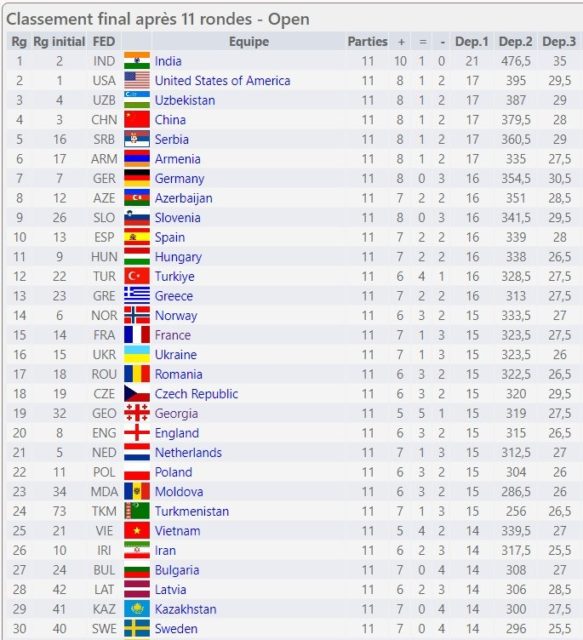
Champions Chess Tour
Trois jours après le retour de Budapest, j’ai disputé le dernier tournoi du Champions Chess Tour, au sein de la Division 1. Etant déjà qualifié parmi le Top 8 du circuit, qui disputera la finale en présentiel à Oslo du 17 au 21 décembre, j’avais surtout à coeur de m’appliquer dans mon jeu dans cette cadence que j’aime bien (10+2). Le résultat est mitigé puisque j’ai remporté mes matches contre Nepo et Grischuk, mais perdu deux fois contre Aronian, et que je termine à la 4e place au classement final. Mais je retiendrai surtout que c’est le deuxième tournoi consécutif de ce circuit où l’on me décerne le prix de beauté ! Cette fois, pour mon attaque de mat contre Nepo…
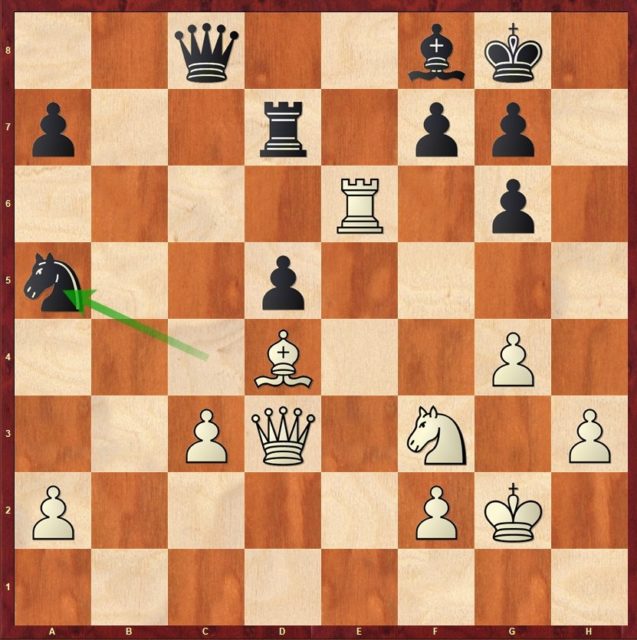
Ici, ma Tour est attaquée, mais un coup de retraite comme 29.Te2 ne laisserait quasiment aucun avantage aux blancs. J’ai passé pas mal de temps (2 minutes) sur 29.Cg5! parce que même si c’est un coup qui est assez évident, je voulais vérifiais que je n’avais oublié aucune défense. Bien sûr, si 29…fxe6 30.Dxg6 gagne instantanément. Si 29…Fe7, c’est facile, la réponse est 30.Cxf7. J’ai aussi calculé 29…Te7 30.Dg3, même si dans celle-là, il aurait encore fallu trouver la punition de 30…f6, à savoir 31.Fxf6! gxf6 32.Txf6 et si l’attaque blanche n’est pas instantanément gagnante, elle sera quand même dévastatrice. Reste 29…Td6. J’avais prévu 30.Df3 comme réponse la plus simple car il ne peut toujours pas prendre en e6, et si 30…Dd7, j’ai 31.Txd6 Fxd6 32.Dxd5. Quant à 30…Dxe6, ça ne laisse aucune chance de forteresse aux noirs. Mais comme j’ai aussi vu 30.Dg3, je ne me suis pas privé de le calculer ! Si 30…fxe6 31.Dh4 c’est mat. Idem sur 30…Dxe6 31.Dh4. Du coup, ça n’a pas été si dur de comprendre que sur 30…Dd8, 31.Te8! était si fort. Ca a un côté spectaculaire mais honnêtement, c’est extrêmement facile… 31…Dxe8 32.Dh4 De4+ et maintenant, 33.Rg3!, la cerise sur le gâteau ! J’aurais pu jouer 33.Rg1 ou même 31.f3, mais j’ai choisi le plus esthétique 😊 ; on utilise le fait que la Td6 bloque l’échec du Fou en d6 !
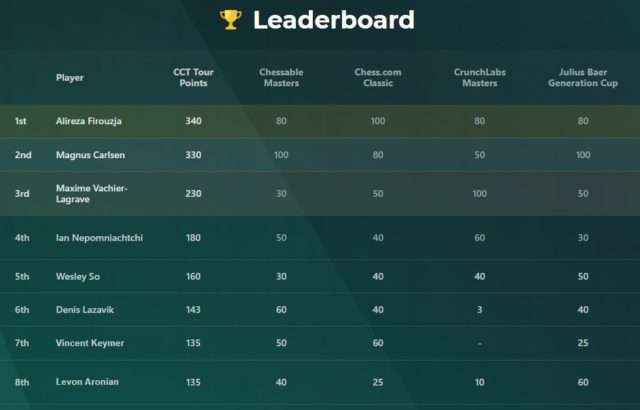
Pour l’anecdote, pendant que je jouais, j’ai pensé à ma partie de 2011 contre Wang Hao (à Wijk aan zee), pas du tout sur cette ouverture mais où j’avais eu ce même thème d’attaque.
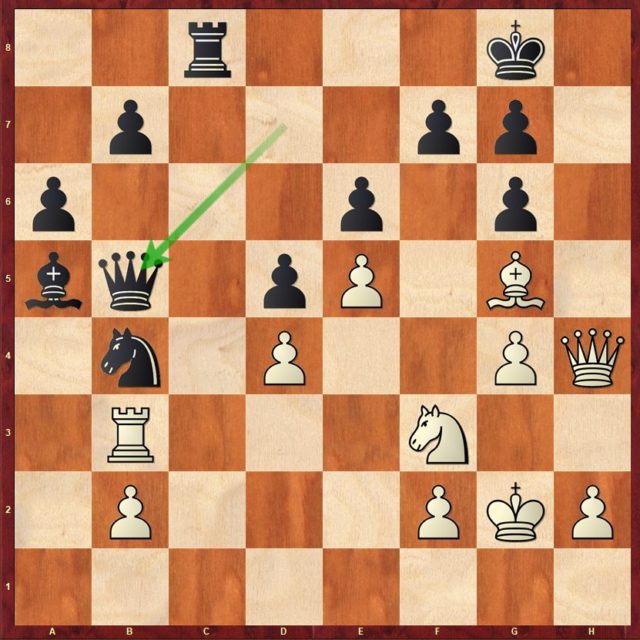
Dans cette position complètement gagnante, je n’ai que l’embarras du choix. 32.Cd2 suivi de 33.Th3 fait l’affaire, tout comme l’esthétique 32.Ff6, suivi de 33.Cg5. Mais j’ai choisi 32.Fe7??, pensant que la menace 33.Cg5 forçait l’abandon, puisque si 32…Cd3 33.Txd3 (33.Cg5?? Cf4+ 35.Rg3 Dxb3+ et si 36.Rxf4? Fd2#) ; mais maintenant, les noirs ont une défense venue d’ailleurs, 33…g5!! et si 34.Cxg5? Dxd3 contrôle h7. Par miracle, les blancs resteraient vivants grâce à 34.Tc3! gxh4 35.Txc8+ Rh7 36.Fxh4, mais dans la partie, j’ai préféré absorber le choc par 33.Txb5 Cf4+ 34.Rg3 (34.Rh1 Tc1+ 35.Cg1 Ce2 aurait été jouer avec le feu !) 34…Ce2+ 35.Rh3 Cf4+ et perpétuel.
Prochaine étape pour moi, Londres. J’y dispute deux tournois de suite, la Global Chess League du 3 au 12 octobre, un tournoi par équipes avec des parties de 20’ sans incrément ! Puis le WR Masters à partir du 14 octobre qui, lui aura la particularité de proposer une formule nouvelle et originale. Un tableau de 16 joueurs avec un système au KO, et la cadence la plus rapide pour être homologuée en classique (1h/30c, 30’/20c + 30’ ko). Cerise sur le gâteau, les deux parties d’un match auront lieu le même jour, avec un éventuel départage en Armaggedon le soir ! Un programme particulièrement chargé nous attend 😊.
Les parties de Budapest :
Les parties du Champions Chess Tour :
La partie de Maxime contre Wang Hao :
Tous les ans au début du mois de septembre, l’immense foire de Châlons-en-Champagne est the place to be. Passage obligé pour les principales personnalités politiques du pays, c’est également un lieu de convivialité et de fête, avec notamment des concerts tous les soirs. En clôture le dimanche 8 septembre, c’est Patrick Bruel, l’un des artistes français les plus connus, chanteur et comédien, qui donnait un concert. L’Echiquier Chalonnais, très actif dans le Grand Est et dirigé par l’ancien Président de la Fédération Française Diego Salazar, avait proposé au chanteur, en tant que bon amateur d’échecs, de disputer une partie amicale contre Maxime. Une initiative similaire avait eu lieu avec Garry Kasparov en 2013. La partie a donc eu lieu dans les loges juste avant le concert. Malgré l’aide de la GM française Marie Sebag, Patrick Bruel s’est incliné avec le sourire, avant de foncer se produire devant les quelque 18.000 spectateurs qui l’attendaient !
